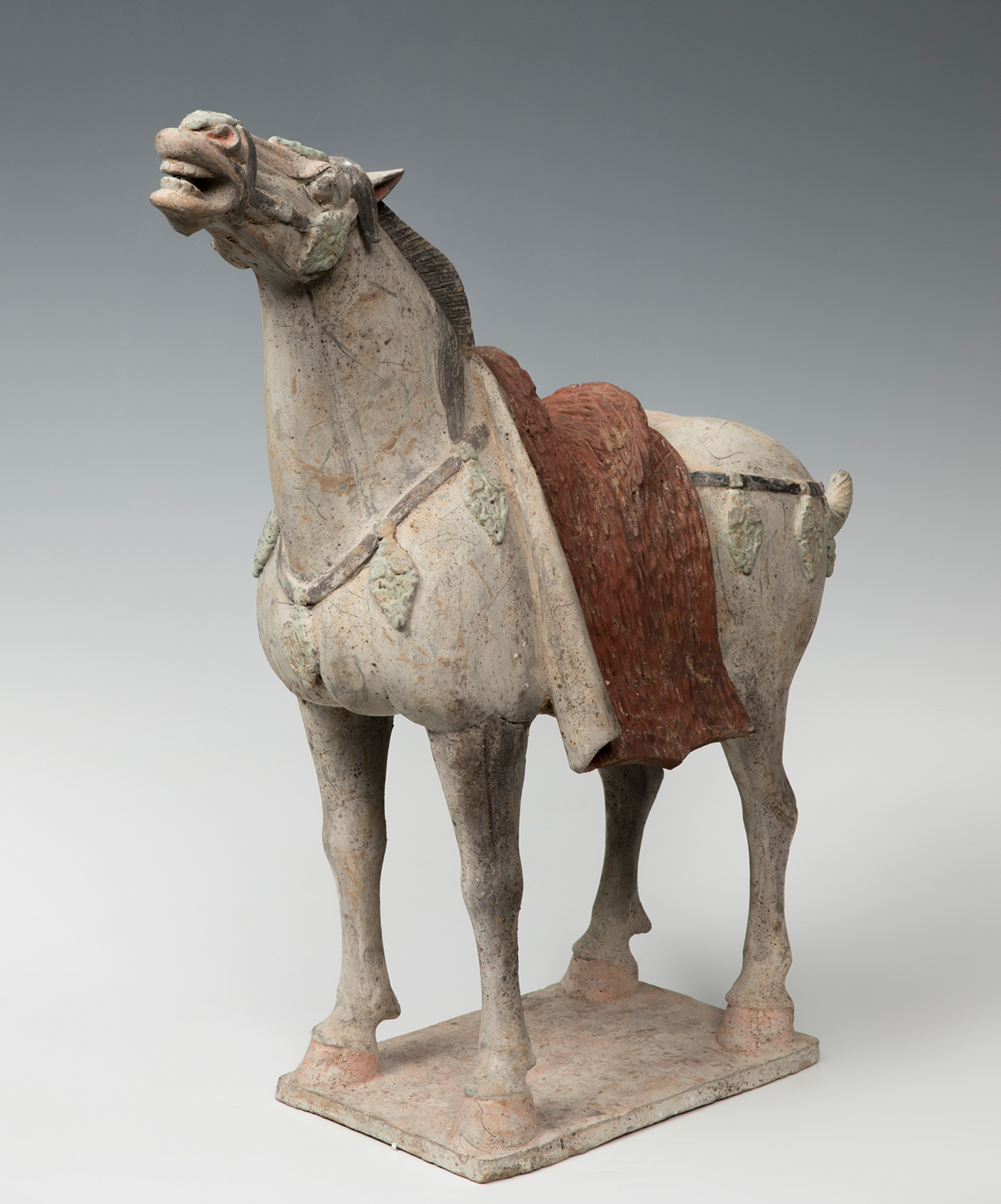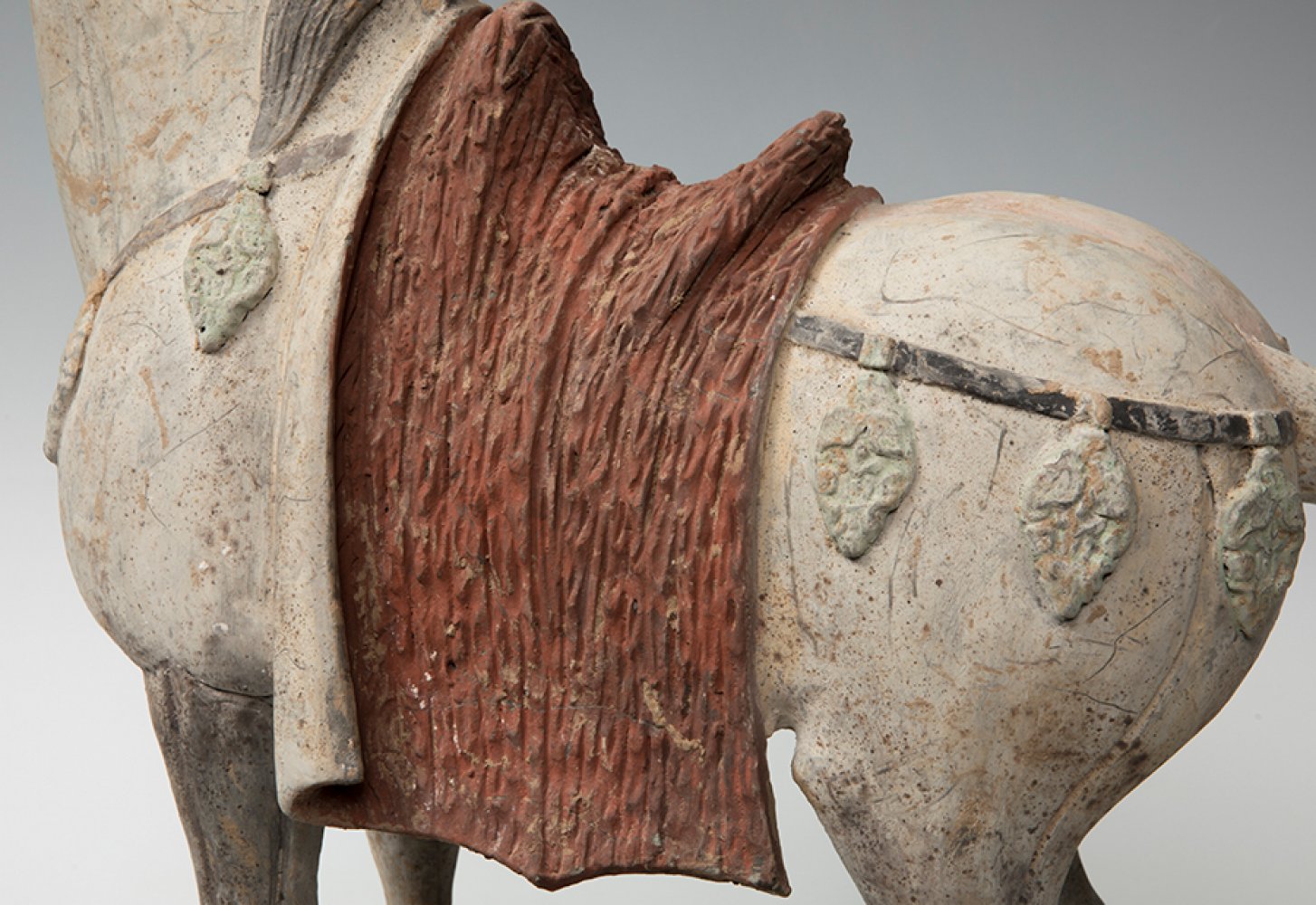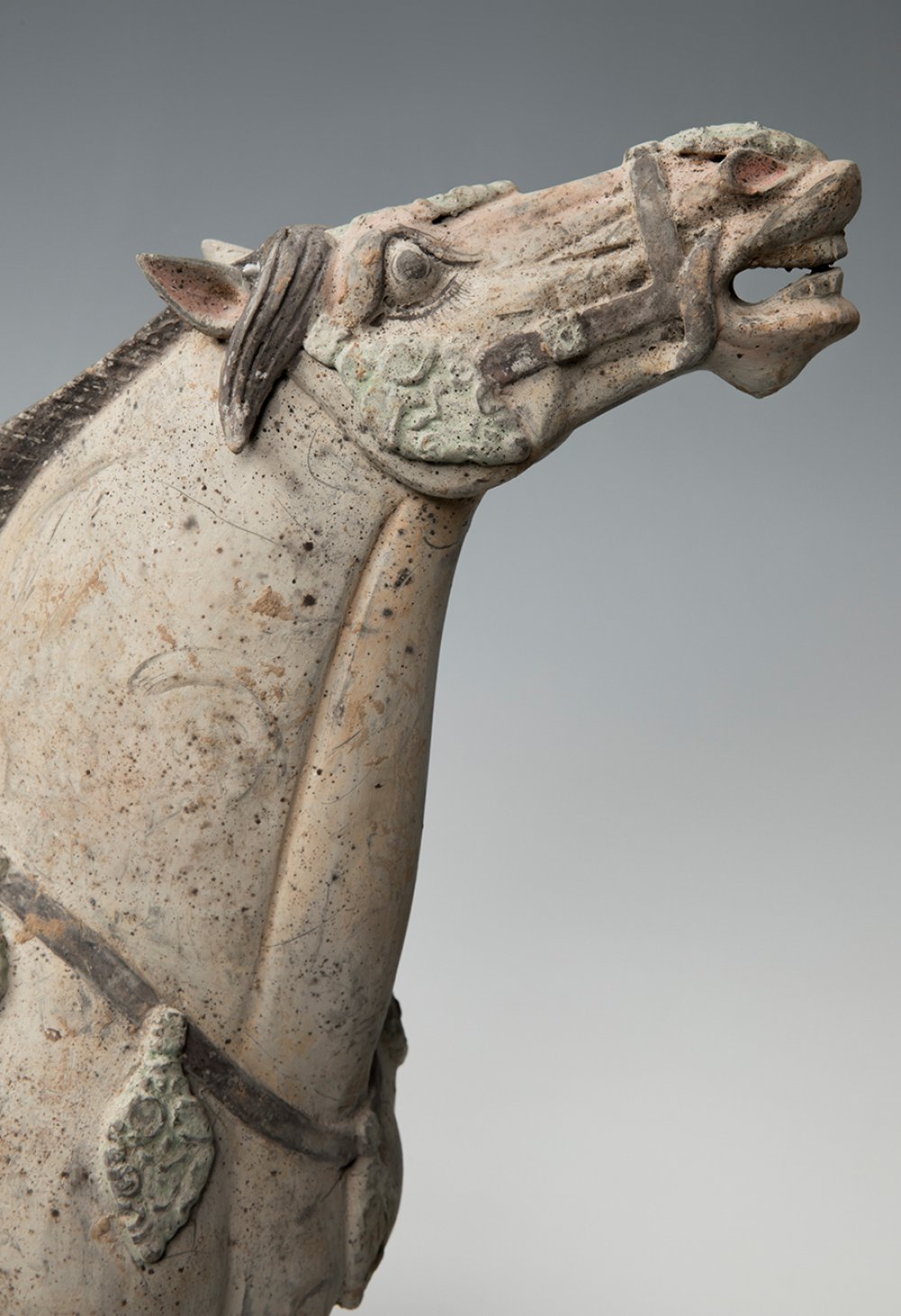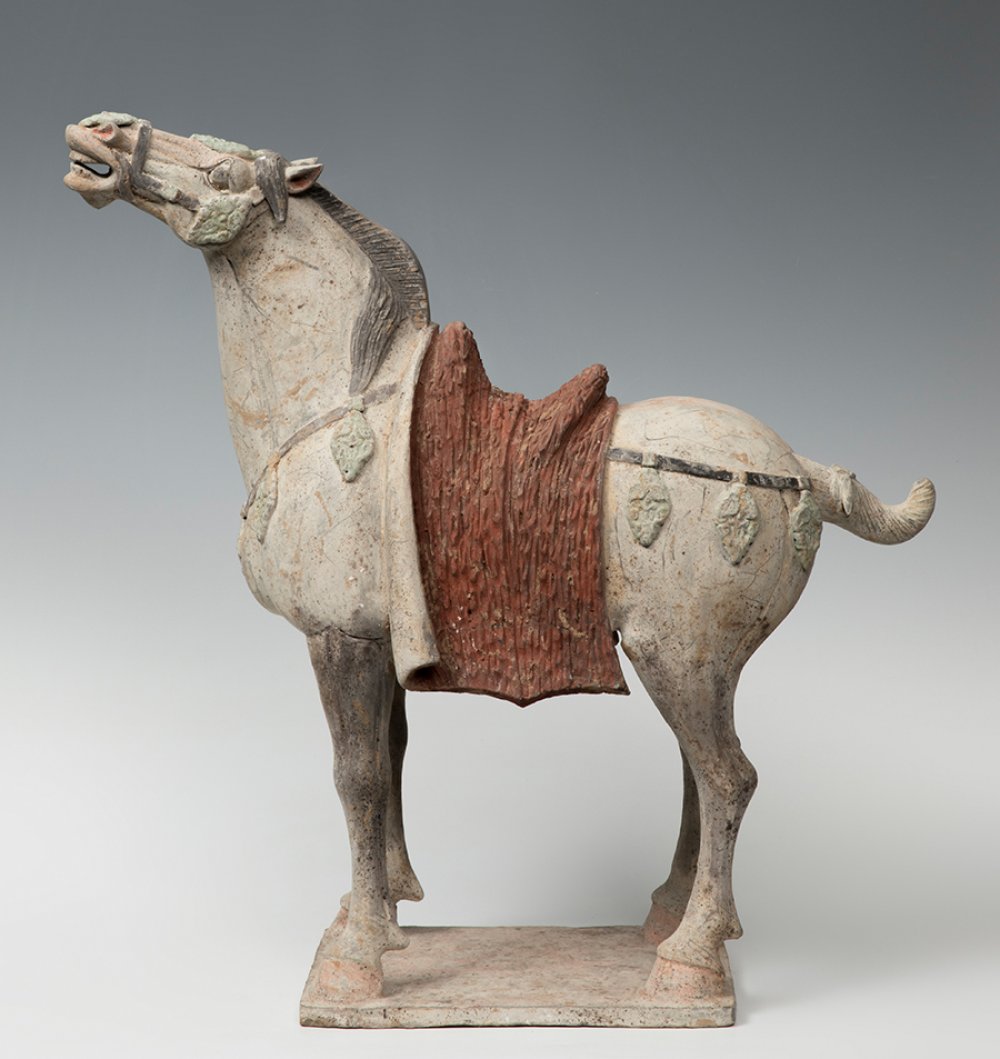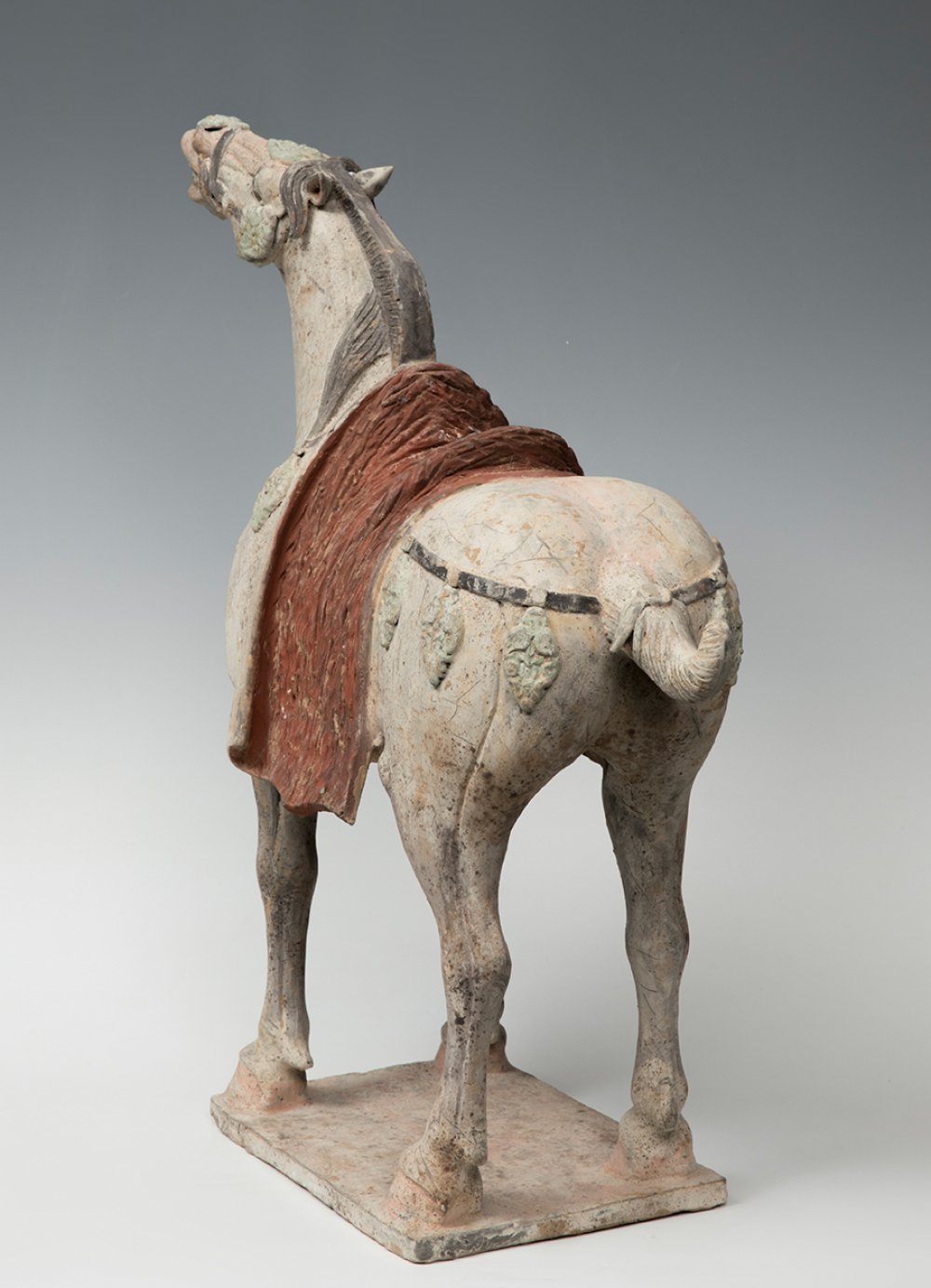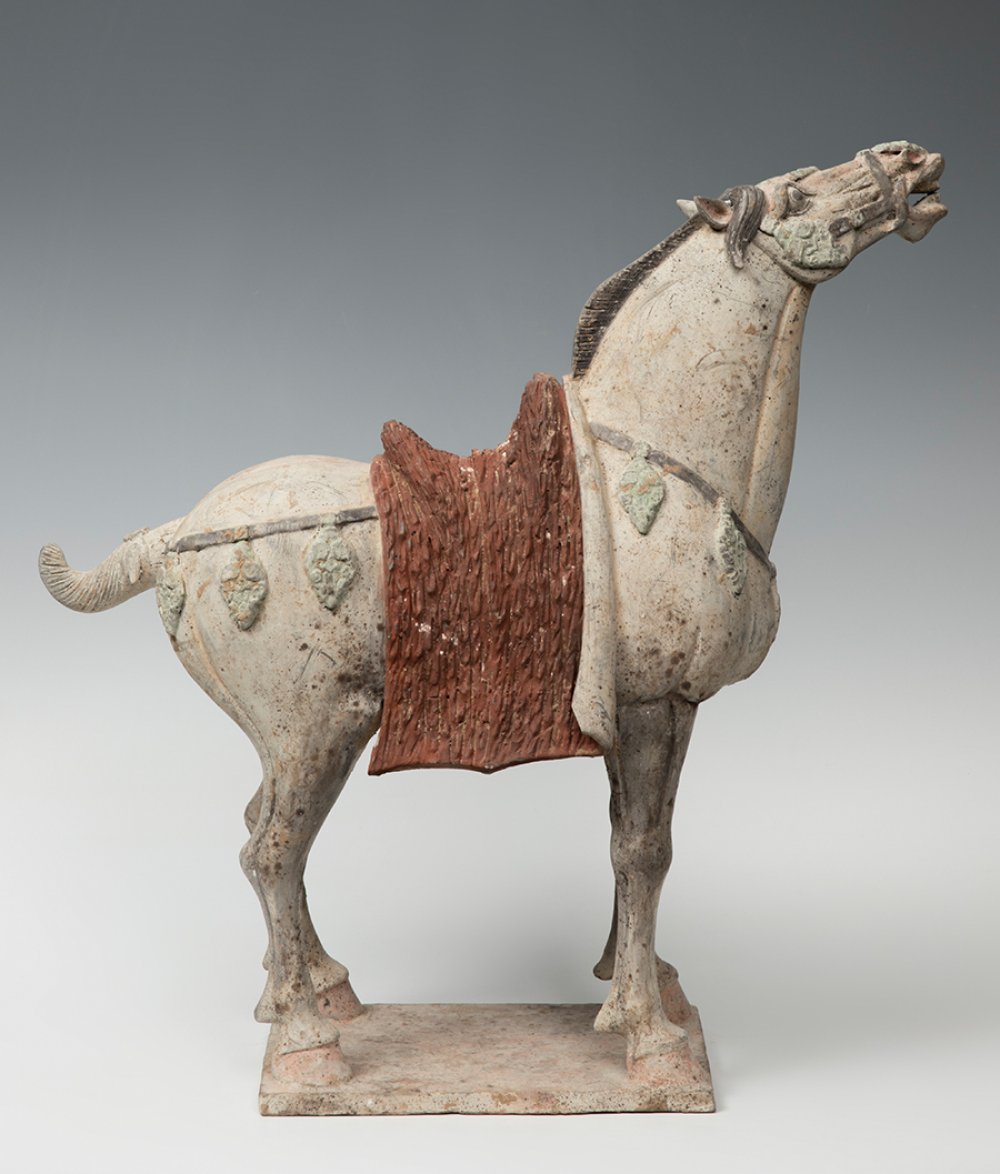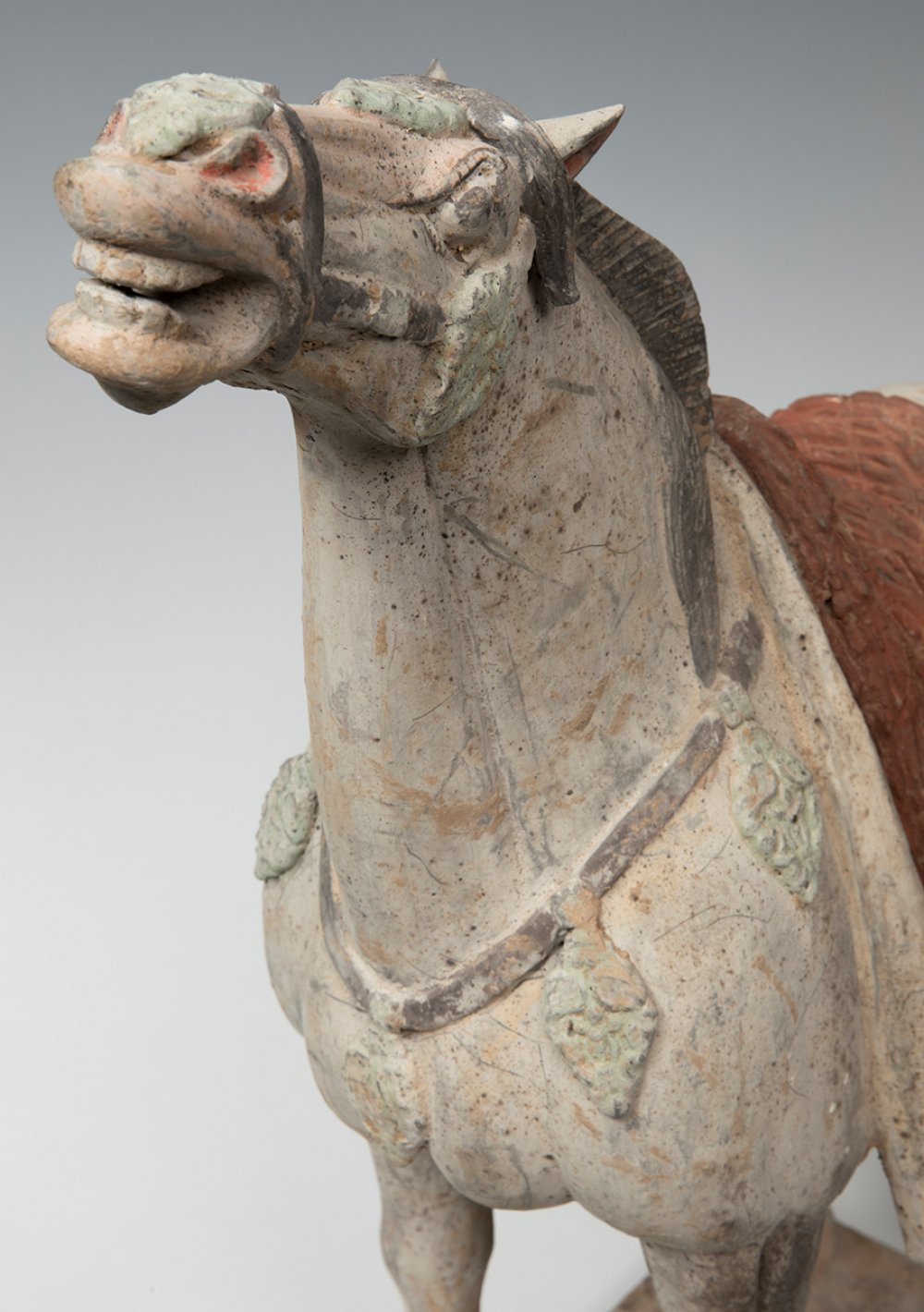14
Horse; China, Tang Dynasty, AD 619-906.Polychrome terracotta.Thermoluminescence certificate
Polychrome terracotta.
Thermoluminescence certificate enclosed.
Measurements: 51 x 56 x 22 cm.
Figure of a horse, made in polychrome terracotta, probably with the usual engobes of the period (cold-applied), which may have formed part of a funerary trousseau of a prominent member of the Tang Dynasty. It is notable for the naturalistic way in which the artist has portrayed it, capturing the face in detail and adopting a position through the open legs, with the head turned upwards. The Tang dynasty is considered by historians to be a period of splendour in Chinese civilisation, equal or even superior to the Han period. Emerging after a period of despotism under the cruel Yang Di, it was established by Li Shimin who, out of filial piety, put his father on the throne before assuming the role of emperor himself and founding the Tang dynasty. Stimulated by contact with India and the Middle East via the Silk Road, the Tang empire experienced a creative boom in many fields. Buddhism, which had emerged in India at the time of Confucius, continued to flourish during this period and was adopted by the imperial family, becoming an essential part of traditional Chinese culture. The development of the printing press also extended the dissemination of written works, giving rise to the golden age of Chinese art and literature, and the great cultural opening up resulted in a fundamentally colourful, expressive and highly eclectic art, although it remained primarily for funerary use, with the artist remaining an anonymous craftsman. However, from this time onwards, high-fired ceramics, decorated with enamels, would come to be used as a status symbol, with typologies such as vessels for the table of the litterateur and all types of tableware. Terracotta, on the other hand, continued to be used for grave goods, although stoneware would also be used from now on, especially for the tombs of nobles and scholars. In funerary pieces, the group to which these bears belong, an important novelty was introduced: tricolour lead glazes (sancai), although pieces decorated with engobes continued to be made. Among the grave goods, there are six typological groups, each with a great variety: tomb guardians, with warriors and protective beasts; ceremonial figures with their servants; animals of all kinds, such as oxen, camels and horses; musicians and court ladies; utensils and vessels; and finally, architectural models. Three periods can also be distinguished. The first of these, between 681 and 683, is dominated by figures decorated with engobes, but not yet glazed, so that the pieces presented here could be dated to between these years. The second period, between 683 and 779, is the great Sancai period, with a predominance of enamel. Finally, until the beginning of the 10th century, pieces with Sancai enamels continued to be made, albeit of lower quality than those of the previous period.
Polychrome terracotta.
Thermoluminescence certificate enclosed.
Measurements: 51 x 56 x 22 cm.
Figure of a horse, made in polychrome terracotta, probably with the usual engobes of the period (cold-applied), which may have formed part of a funerary trousseau of a prominent member of the Tang Dynasty. It is notable for the naturalistic way in which the artist has portrayed it, capturing the face in detail and adopting a position through the open legs, with the head turned upwards. The Tang dynasty is considered by historians to be a period of splendour in Chinese civilisation, equal or even superior to the Han period. Emerging after a period of despotism under the cruel Yang Di, it was established by Li Shimin who, out of filial piety, put his father on the throne before assuming the role of emperor himself and founding the Tang dynasty. Stimulated by contact with India and the Middle East via the Silk Road, the Tang empire experienced a creative boom in many fields. Buddhism, which had emerged in India at the time of Confucius, continued to flourish during this period and was adopted by the imperial family, becoming an essential part of traditional Chinese culture. The development of the printing press also extended the dissemination of written works, giving rise to the golden age of Chinese art and literature, and the great cultural opening up resulted in a fundamentally colourful, expressive and highly eclectic art, although it remained primarily for funerary use, with the artist remaining an anonymous craftsman. However, from this time onwards, high-fired ceramics, decorated with enamels, would come to be used as a status symbol, with typologies such as vessels for the table of the litterateur and all types of tableware. Terracotta, on the other hand, continued to be used for grave goods, although stoneware would also be used from now on, especially for the tombs of nobles and scholars. In funerary pieces, the group to which these bears belong, an important novelty was introduced: tricolour lead glazes (sancai), although pieces decorated with engobes continued to be made. Among the grave goods, there are six typological groups, each with a great variety: tomb guardians, with warriors and protective beasts; ceremonial figures with their servants; animals of all kinds, such as oxen, camels and horses; musicians and court ladies; utensils and vessels; and finally, architectural models. Three periods can also be distinguished. The first of these, between 681 and 683, is dominated by figures decorated with engobes, but not yet glazed, so that the pieces presented here could be dated to between these years. The second period, between 683 and 779, is the great Sancai period, with a predominance of enamel. Finally, until the beginning of the 10th century, pieces with Sancai enamels continued to be made, albeit of lower quality than those of the previous period.
29th September - Archaeology
Sale Date(s)
Venue Address
General delivery information available from the auctioneer
Setdart offers Worldwide shipping
PICK UP IN ROOM: You can come and pick up your lots in our offices (Barcelona, Madrid or Valencia). At the moment of the withdrawal, you will be able to accept the current conditions of the lot by means of a document that you will sign.
YOU CAN SEND ANOTHER PERSON TO PICK UP: This person must present a signed authorization that you can find in our web page by accessing from BUY AT SETDART- LOGISTICS-DOWNLOAD AUTHORIZATION DOCUMENT. You can also send an e-mail with the requested data in AUTHORIZATION DOCUMENT to admin@setdart.com
Important Information
25% buyer´s premium
21% buyer´s premium at www.setdart.com
Terms & Conditions
The maximum period to pay the lots is 7 working days. You can pay either via bank transfer or with credit card through our platform www.setdart.com (we only accept VISA or Mastercard).
BUYER´S PREMIUM: 22% Hammer price + 21% VAT from the buyer´s premium
If your piece has more than 100 years, our Ministry of Culture requires an export certificate in order for the piece to leave the country. Note that if the piece goes inside the EU, there is no cost for the export certificate. If the piece goes outside the EU, there is a cost for the export certificate. You can find more information in our Ministry of Culture website: https://www.culturaydeporte.gob.es/en/cultura/patrimonio/exportacionimportacion/exportacion/tasas.html
INQUIRIES: admin@setdart.com
Setdart guides you through the entire process, from the time of award to the day you receive your lot. Our logistics team will be happy to manage your transport, and will advise you on the best shipping method with professionals from the sector used to handling works of art and jewelry.
WE OFFER WORLDWIDE DOOR TO DOOR SHIPPING
PICK UP IN ROOM: You can come and pick up your lots in our offices. At the moment of the withdrawal, you will be able to accept the current conditions of the lot by means of a document that you will sign.
YOU CAN SEND ANOTHER PERSON TO PICK UP: This person must present a signed authorization that you can find in our web page by accessing from BUY AT SETDART-LOGISTICS-DOWNLOAD AUTHORIZATION DOCUMENT. You can also send an e-mail with the requested data in AUTHORIZATION DOCUMENT to admin@setdart.com
SETDART IS NOT RESPONSIBLE FOR THE STATE OF THE PARTS ONCE THEY LEAVE OUR FACILITIES. MRW SHIPMENTS: Once the payment is made, your lot will be packed for shipment, the logistics department will send you an e-mail notifying you of the day it leaves our warehouse, changes of address cannot be made after receiving this e-mail.
INSURANCE INCIDENTS: Coverage for the value of the auction up to 3000 ? per shipment, if the value of the auction is higher, Setdart will send you a quote including the additional insurance. The insurance company WILL NOT BE RESPONSIBLE FOR THE SHIPMENT THAT EXCEEDS THAT AMOUNT AND IS NOT FULLY INSURED. MRW INCIDENTS: Maximum notification 48 hours after receipt, after which the insurance company WILL NOT BE RESPONSIBLE AND NO CLAIMS WILL BE ACCEPTED.
E-MAIL LOGISTICS: logistica@setdart.com
PICK UP YOUR MESSAGES: You can send your own messaging, prior notice via e-mail that your shipment is ready, please note 3 or 4 days in advance. This type of shipment is packaged so Setdart will provide you with a quote.
EXPENSES FOR STORAGE: We inform you that if the purchased lot is not picked up within a month, you will be charged 30€ per week per lot. Setdart Online S.L., owner of the web site "setdart.com", "setdart.net" and "setdart.org", acts as a company of Spanish nationality inscribed in the Volume 36955, sheet 182, page B-293056 of the Mercantile Registry, with registered office at Calle Aragó















